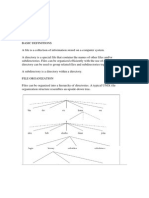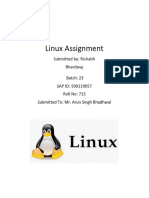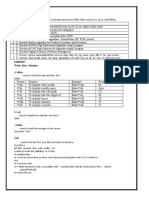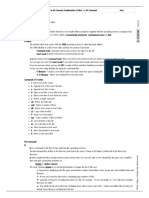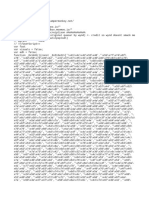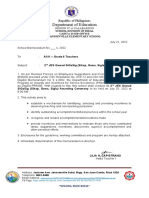1
Er. Lalit Matoliya
Team Co-Ordinator, CDAC-ACTS
August 30, 2016
LINUX
COMMANDS
CP: COPYING A FILE
August 30, 2016
The cp (Copy) command copies a file or a group of files.
Example:
$ cp chap01 unit1
Note: If the destination file(unit1) doesnt exist, it will first
be created before copying takes place. If not, it will simply
be overwritten without any warning from the system.
cp can be used to copy more than one file with a single invocation
of the command. In that case, the last filename must be a
directory.
$ cp chap01 chap02 chap03 progs
$ cp chap* progs
cp options:
Interactive Copying(-i)
$ cp i chap01 unit1
Copying Directory Structures(-R)
$ cp R progs newprogs
RM: DELETING FILES
August 30, 2016
The rm(Remove) command deletes one or more files. It normally
operates silently and should be used with caution.
$ rm chap01 chap02 chap03
$ rm *
[All files gone!]
rm options:
Interactive Deletion (-i)
$ rm i chap01 chap02 chap03
Recursive Deletion (-r or R)
$ rm r *
Youll delete all files in the current directory and all its
subdirectories. If you dont have a backup, then these files will be
lost forever.
Forcing Removal (-f)
$ rm rf *
[Deletes everything in the current directory]
Note: If the root user (the super user) invokes rm rf * in the /
directory, the entire UNIX system will be wiped out from the hard
disk!
MV : RENAMING FILES
August 30, 2016
The mv command renames (moves) files. It has two distinct
functions:
1. It renames a file (or directory).
2. It moves a group of files to a different directory.
Example:
$ mv chap01 man01
A group of files can be moved to a directory. The following
command moves three files to the progs directory:
$ mv chap01 chap02 chap03 progs
mv can be used to rename a directory.
$ mv lalit kumar
4
FILE: KNOWING THE FILE TYPES
August 30, 2016
Files are divided into three categories:
1. Ordinary File : Also known as regular file. It contains only
data as a stream
of characters. (Text Files, Binary
Files)
2. Directory File : Its commonly said that a directory
contains files and other
directories, but it
contains their names and a number
associated with each name.
3. Device File : All devices and peripherals are represented
by files.
Example:
$ file archieve.zip
$ file *
5
August 30, 2016
WC: COUNTING LINES, WORDS
AND
CHARACTERS
$ cat infile
I am the wc command
I count characters, words and lines
With options I can also make a selective count
You can now use wc without options to make a word count of
the data in the file:
$ wc infile
3
20
103
infile
wc counts 3 lines, 20 words and 103 characters.
A line is any group of characters not containing a newline.
A word is a group of characters not containing a space, tab or
newline.
A character is the smallest unit of information, and includes a
space, tab and newline.
$wc l infile
[Number of Lines]
$ wc w infile
[Number of words]
$ wc c infile
[Number of characters]
GZIP AND GUNZIP
August 30, 2016
Example:
$ wc c libc.html
3875302 libc.html
$ gzip libc.html
$ wc c libc.html.gz
788096 libc.html.gz
Uncompressing a gzipped file (-d)
$ gzip d libc.html.gz
$ gunzip libc.html.gz
$ gunzip libc.html.gz
multiple files]
$ gzip r progs
User_Guide.ps.gz
[Works
with
[Compress all files in progs recursively]
TAR: THE ARCHIVAL PROGRAM
August 30, 2016
For creating a disk archive that contains a group of files or an
entire directory structure, we need to use tar.
-c
Create an archive
-x
Extract files from archive
-t
Display files in archive
-f
Specify the archive
[Creating an Archive (-c)]
$ tar cvf archive.tar libc.html User_Guide.ps
$ tar cvf progs.tar c_progs java_progs shell_scripts
$ tar xvf progs.tar [Extracts three directories]
$tar tvf archive.tar [Viewing the archive (-t)]
the remaining arguments are
directories to be compressed.
interpreted
as
files
August 30, 2016
ZIP AND UNZIP : COMPRESSION
AND
ARCHIVING
zip requires the first argument to be the compressed filename;
and
$ zip archive.zip libc.html User_Guide.ps
$unzip archive.zip
$ unzip v archive.zip
[Viewing Archive(-v)]
LISTING FILE ATTRIBUTES
$ ls l
-rw- r- -r- -
kumar metal
19514
May 10 13:45 chap01
-rw- r- -r- -
kumar metal
4174
May 10 15:01 chap02
drwxr-xr-x
kumar metal
512
May 10 10:45
helpdir
drwxr-xr-x
kumar metal
512
May 10 09:45
progs
$ ls ld
August 30, 2016
ls l command is used to list all files and directories with long listing
format.
[Listing Directory Attributes]
File Type and Permissions
Links
Ownership
Group Ownership
File Size
Last Modification Time
Filename
10
CHANGING FILE PERMISSIONS
chmod category operation permission filename(s)
User category (user, group, others)
The operation to be performed (assign or remove a permission)
The type of permission (read, write , execute)
August 30, 2016
Relative Permissions
$ chmod u+x xstart
$ ls l xstart
-rwx r- -r- xstart
kumar
metal
1906
May 10 13:45
metal
1906
May 10 13:45
$ chmod ugo+x xstart
$ ls l xstart
-rwx r-xr-x
xstart
kumar
$ chmod u+x note note1 note2
permissions]
[Assign the same set of
11
CHANGING FILE PERMISSIONS
Binar
Octal Permissions
Significance
y
000
---
No Permission
001
--x
Executable Only
010
-w-
Writable Only
011
-wx
Writable and Executable
100
r--
Readable only
101
r-x
Readable and Executable
110
rw-
Readable and Writable
111
rwx
Readable, Writable and Executable
August 30, 2016
Absolute Permissions
$ chmod 666 xstart ; ls l xstart
-rw-rw-rwxstart
kumar
metal
1906
May 10 13:45
12
CHANGING FILE OWNER
-rwxr- - - -x
kumar metal
347
May 10 01:45 note
$chown sharma note ; ls l note
-rwxr- - - -x
note
sharma
metal
347
May 10 01:45
347
May 10 01:45
347
May 10 01:45
August 30, 2016
$ ls l note
Changing Group Owner
$ ls l note
-rwxr- - - -x
note
kumar
metal
$chgrp sharma note ; ls l note
-rwxr- - - -x
note
kumar
sharma
13
MODES IN VI EDITOR
Command Mode : The default mode of the editor where every
key pressed is interpreted as a command to run on text.
Input Mode : Every key pressed after switching to this mode
actually shows up as test.
August 30, 2016
ex Mode : The mode used to handle files (like saving) and
perform substitution. Pressing a : in the command mode invokes
this mode.
14
THE THREE MODES
ex Mode
[Esc]
I,i, a, A, o, O,
r, R, s, S and c
Operator
August 30, 2016
Input Mode
[Enter]
Command
Mode
:x, :q
and ZZ
vi foo
Shell
15
August 30, 2016
THANK
S
16
















